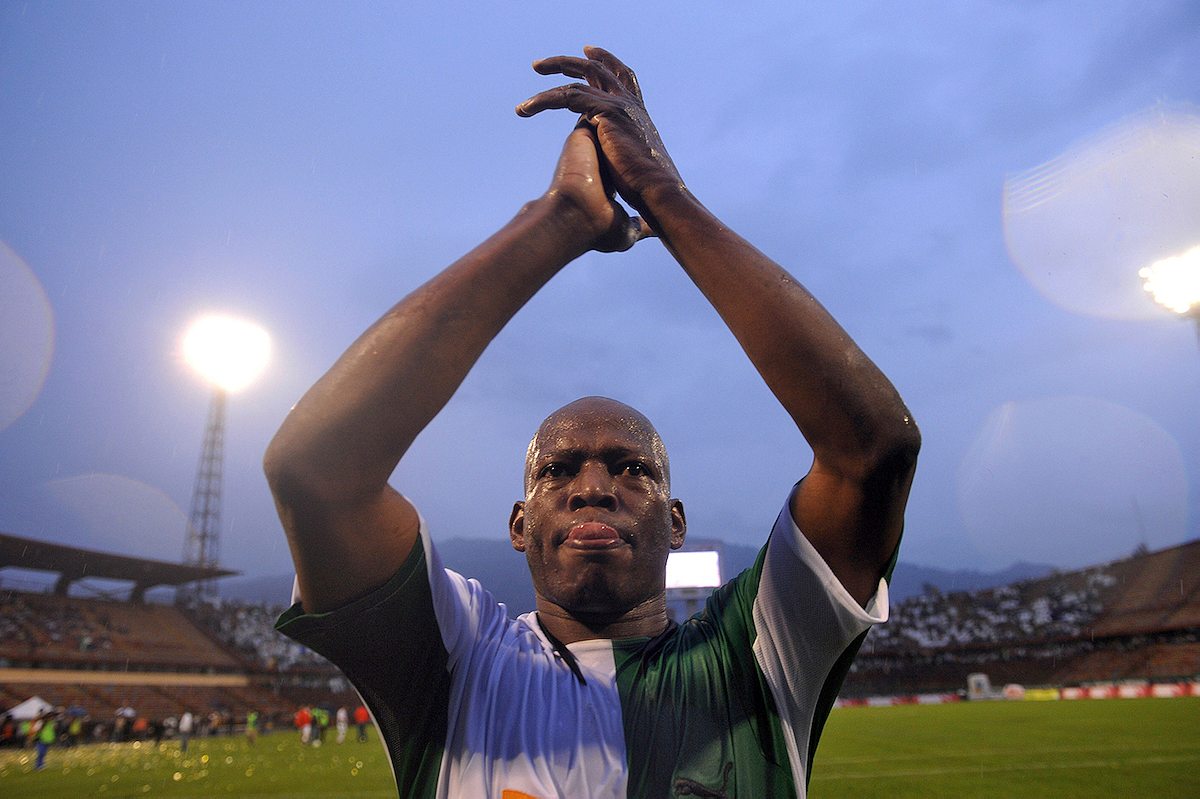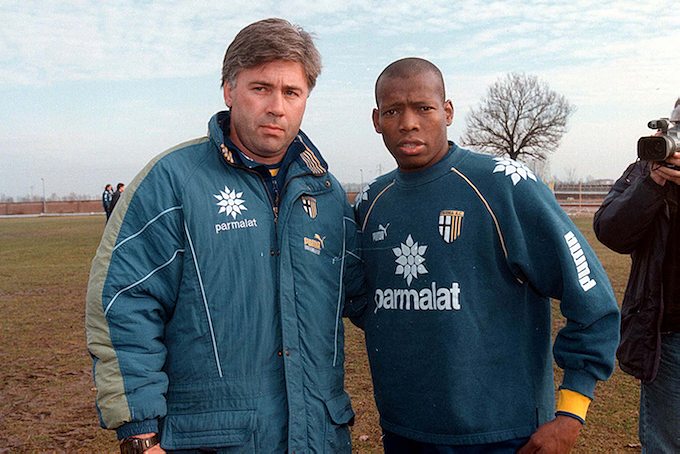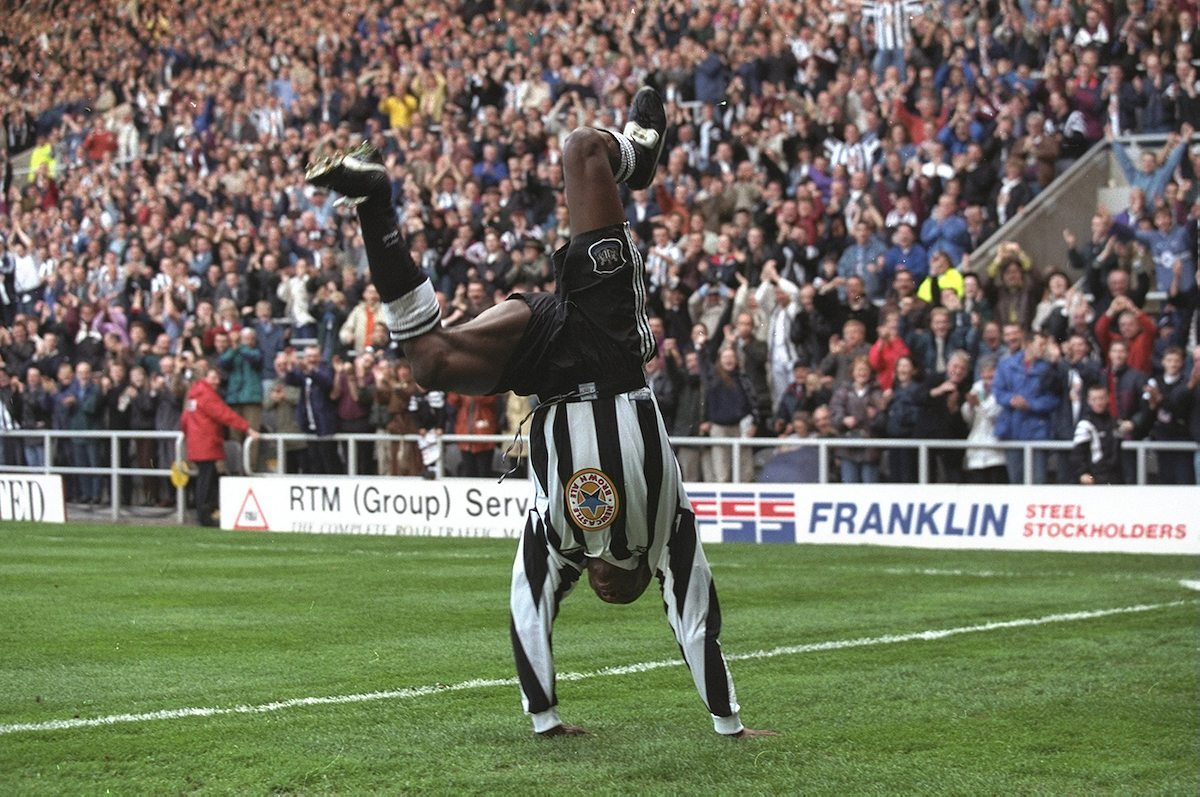Why is one of the greatest players in Colombian history also one of the most controversial? The answer may lie in the color of his skin.
September 5th, 1993 is more or less regarded as major event in Colombian history, a sort of soccer version of Independence Day. That is the date that the Colombian and Argentinian national football teams met in Buenos Aires for the last of their qualifying matches for the 1994 USA World Cup. Whichever team won would go straight to the World Cup. The loser would face Australia in a playoff. A tie would have sufficed for Colombia, but instead they won the match 5-0. It remains the biggest win in Colombia’s history.
A player known simply as “El Tino” scored the second of Colombia’s goals—skilfully evading two defenders and the goalkeeper, and then scoring as he fell to the ground—and the fourth, a clever chip, before assisting teammate Adolfo ‘El Tren’ Valencia for the fifth. The day cemented Faustino Asprilla’s place in Colombian history.
Asprilla and the rest of that team sent our soccer-crazy country into a frenzy, into the collective delusion that we could win every game, that we could win it all. We were unstoppable. In the United States, though, the team is probably better remembered for defender Andrés Escobar, whose life story, along with that of druglord Pablo Escobar, was the subject of the documentary film “The Two Escobars”. Andrés scored an own goal while playing against the United States in the ’94 World Cup and was murdered in Medellín, Colombia’s second largest city, a few weeks later. Many people thought the two events were connected, but in reality Andrés’ murder was even more absurd: he bumped into the wrong people at the wrong time and a bar dispute turned into tragedy. His death was a symbol of the lawlessness that Pablo Escobar’s era had brought to the city and much of the country.
NOBODY HAD EVER BEATEN ARGENTINA AT THEIR HOME GROUND BEFORE
But South American football fans remember that Colombian team from games like the one in Buenos Aires that night in September. Nobody had ever beaten Argentina at their home ground before. So dominant was Colombia’s performance that the Argentinian fans at the River Plate stadium, including Diego Maradona, got on their feet at the end of the game and applauded the Colombian players. For Colombians that victory represented the country’s huge potential—off the field as well as on it. And although the whole team was talented, if there was one man that embodied the hope of a country that it might flourish at last, that man was Tino.
Faustino Hernán “El Tino” Asprilla Hinestroza lived the dream. He was nicknamed “Tino” not just because those were the last syllables in his given name, but because that word in Spanish means “aim” and he had a wonderfully accurate shot. He could score from anywhere. In British stadiums there’s a popular chant for lethal strikers: “He scores when he wants! He score when he wants!”. That was Tino: he seemed to be able to score whenever and from wherever on the field he wanted to. Asprilla was never a player that dictated the pace of the game. He never seemed to care much about what exactly what was going on off the ball. He was never a tactician. But he was always there, playing the game like a little kid amusing himself, just waiting for the perfect moment to score.

Tino was a threat in part because he didn’t look like he could be a serious striker. He always seemed to wear the wrong size of shirt (and shorts). And so sometimes fullbacks didn’t mark him because they forgot how high he could jump, and how fast he could run, and how easily he could dance the ball away. He was never violent in a game. He didn’t need to be. Football for him was not about hurting your rival, but about enjoying the game. Both on and off of the pitch he was playful, he was unpredictable. But since he was black in a country that still hasn’t come to terms with its black population, he had a rough time while trying to be himself. When he became an international superstar, he also became the most beloved black person in Colombia, and the most criticized one.
His public persona transcended football. Not only did he score goals, he dated supermodels discreetly (he has never been willing to confess their names, though many rumours have arisen) and also dated famous singers, less discreetly (his relationship with Lady Noriega in the late ’90s was food for every gossip magazine). He got publicly drunk in town fairs and celebrations, and sometimes was late to training because of his hangovers, which were more often the result of his addiction to dancing salsa than to alcohol. He also shot his gun in the air to celebrate football victories and at random parties, and the size of his… goalpost was the center of much speculation—”is he really that well endowed?”—until a local “erotic” magazine ended the guessing in 2007 with a centerfold nude picture (yes, yes he is). His adventures with the ball or without it, as well as his very nasal voice and gawky features, made him a favorite cartoon of national TV and radio comedy shows.
Asprilla was also one of the first public figures in Colombia to speak against racism. “Some people don’t like me because I am black”, he told the press. But he didn’t want to become the spokesman for the country’s racial issues. In an interview in 2013, he recounted that he had often been insulted by rival fans because of his race, but that he didn’t care, because “those are things that happen in the pitch and should stay there”. He complained that other players care too much about these insults and that one day “players will play with a recorder in their shorts so the can sue when they are insulted. But what can you do if somebody is black and somebody else is white and yet another is yellow!”.
BLACK AREAS IN THE COUNTRY USUALLY LACKED BASIC INFRASTRUCTURE, WHICH MEANT THAT SOCIAL MOBILITY WAS ALMOST IMPOSSIBLE
Asprilla was born in 1969 in Tuluá, a small town in the Valle del Cauca region in the western part of the country. The most recent national census found 28% of the Valle del Cauca inhabitants identify themselves as “afro-colombian” (at the national level, only 10% identify as such). But for the national media, centered in the capital, Bogotá (where, according to that same 2005 census, only 1.5% of the population identifies itself as “Afro-colombian”), a black person was still an oddity when Asprilla came on the scene.
During the colonial period, large numbers of black slaves arrived in Colombia, and by the 19th century Colombia’s black population was scattered around the Pacific and the Atlantic coasts, in the western and northern part of the country. When slavery was abolished in 1851 many freed black men, instead of having to work for their former owners for miserable wages, preferred to take their families into unexplored territories towards these areas, where they could meet other black people and create their own communities there. Some of them decided to create new towns, while others gravitated towards “palenques”, towns that were built even before abolition by runaways. Many others remained in the cities of the north that had been slave trading posts, such as Cartagena, where they would be cast into racially segregated neighborhoods.

This division meant that for a century and a half–and until the 1991 Constitution–the official stance of the Colombian government was basically to ignore the existence of these people, since they very seldom had anything to do with the affairs of main cities and towns. Black areas in the country usually lacked basic infrastructure, including schools, which meant that social and even geographical mobility was almost impossible. Bogotá, atop a mountain in the middle of the country, didn’t see the arrival of many black people because there was usually nothing for them to do there, except for low-waged, unskilled jobs, far away from their families.
Because of all of this, the experience of black Colombians hasn’t usually entered the national consciousness, nor been represented by mainstream media, except in areas which already had some black presence (like Cartagena), or that have seen some black migration (like Cali). Even so, there have been black players in the Colombian national football team almost since its beginnings, with Ricardo “Bollo de Yuca” Granados the first one to be called up in the 1930’s. A few other black Colombians managed to thrive in other disciplines throughout the 20th Century, such as Antonio “Kid Pambelé” Cervantes in boxing, and Édgar Rentería in baseball. By 1990, when Tino arrived in the spotlight, football seemed to be the place where black Colombians could be recognized as an integral part of the country. From an outside perspective, there didn’t seem to be a racial barrier in the sport, as every team in Colombia featured black players and a lot of them were the stars. The national team that qualified for the 1990 World Cup in Italy was no exception, as it featured players Miguel “Niche” Guerrero, Bernardo Redín, Luis Carlos Perea, Arnoldo Iguarán and Freddy Rincón, and was coached by Francisco “Pacho” Maturana. Rincón became a national hero after he scored a last minute, game tying goal against Germany in the group stage that sent Colombia to the Round of 16.
Growing up in Bogota, the black people I knew were characters in American series we watched on cable, or the protagonists of history books. I knew that black Colombians existed, but I just never encountered them in my daily life. Tino Asprilla changed this for me and probably for a generation of city-dwellers. He made Afro-colombians concrete in our heads.
Asprilla made his professional debut in 1989 with Cúcuta Deportivo–a team notorious for its losing streaks–but transferred next season to Medellín’s Atlético Nacional, which by then was rumored to be owned by Pablo Escobar. He arrived to the first team a little after Nacional had won the Copa Libertadores title (the first Colombian team to do so) that year and stayed there for three years. He played in 78 games for Nacional, scored 38 goals, and won a league title. His goals at club and international level made him a prominent target for the major European sides and in 1992, after being sought by Juventus, Fiorentina and Barcelona, he was transferred to Italian side Parma AC.

Tino arrived in Italy when Serie A was the wealthiest and most glamorous football league in the world. Parma AC, funded by local dairy giants Parmalat, had just spent their first two seasons ever in the top division, and had won their first piece of elite silverware, the Coppa Italia in 1992. It won three continental trophies during Asprilla’s three and a half seasons there.
Asprilla was at one of the emerging powers of Italian football at a time when Italian teams dominated European competition. Parma beat Belgian side Royal Antwerp 3-1 to win the 1993 Cup Winners’ Cup, then they beat AC Milan 2-1 on aggregate to obtain that season’s European Super Cup. Finally they snatched the 1995 edition of the UEFA Cup when they beat Juventus in the final with an aggregate score of 2-1.
While in Italy, Asprilla was rated as one of the top five players in Serie A. His name soon started to pop up regularly as a contender for the Ballon D’Or. Back home his success had captivated the country. Every weekend the national broadcaster carried Parma’s matches, and ordinary Colombians could be found cheering on their hero while eating breakfast in their pyjamas.
Asprilla had been raised in poverty alongside six siblings, by his mom’s care and his dad’s income as a worker in a sugarcane plantation. Now he was a superstar. Everybody in Colombia knew who Tino was, and he wasn’t shy about making his presence known. Back at home, he wore fancy designer clothes with loud colors, and usually went about in expensive cars. He spoke all the time— he always had a story to tell—and was a journalist’s dream, always making stirring controversy.
One of the first controversies in Tino’s career came in April of 1993, when he went back to Tuluá to visit his sick mother. As he was driving his car in the street, a bus cut him off. He got out and, angry as he was, he kicked the bus, injuring himself and missing four weeks of games. Initially, Colombian media reported that Tino had been in a car accident while driving drunk. Many op-eds were written lambasting Asprilla’s “dubious moral stance” and proclaiming his “fall from grace”. Eventually it was proven that there was no alcohol involved, and Tino went back to Parma. Still, many analysts opined that Tino was not ready to face the challenges that fame brought with it, and that after a disappointing performance with the national team in the 1992 Barcelona Summer Olympics, maybe he wasn’t Team Colombia material after all. It was a claim that became more popular in May, when Asprilla threatened to leave Parma because the team’s coach, Nevio Scala, had benched him during the Cup Winners Cup final—he was still suffering from the injury incurred from kicking the bus back in Tuluá.
SUDDENLY, COLOMBIA WAS EVERYBODY’S TIP TO WIN THE WORLD CUP IN THE UNITED STATES, INCLUDING PELÉ’S
Asprilla earned a new nickname in Colombian media—“Desatino,” which translates as “blunder.” Still, coach Maturana decided to take him to Ecuador for the Copa America, where Colombia finished third. Maturana and his assistant, Hernán Darío “Bolillo” Gómez, had been building a national side based on players that had grown up with each other at Atlético Nacional. So even though Tino didn’t score in the tournament, he was starting to form a close bond at international level with some of the teammates that he had met in Medellín, such as René Higuita, Víctor Hugo Aristizábal, Mauricio “Chicho” Serna, and Andrés Escobar. The media sniping continued but his place in the national team by now was undisputed.
Those doubts turned into massive expectations after Asprilla’s astonishing performance in the 5-0 victory in Buenos Aires. Colombia had humbled the World Cup finalists and reigning Copa América Champions. Suddenly, Colombia was everybody’s tip to win the World Cup in the United States, including Pelé’s. Hopes were even higher with a group that featured a weak home team, Romania and Switzerland. But the overconfidence of the team, coupled with the pressure of the national media and still-obscure threats from gambling mobsters startled the team. Colombia lost its first two games of the tournament and was promptly eliminated in the first round. Tino didn’t score and his performance revived an old criticism: “why isn’t Asprilla as good with the national team as with his club?”.
This was around the time I started to get really interested in football. I was about six years old, and I noticed something then about the black players in the team. Whenever they made a mistake, some people watching the game would scream “¡Negro hijueputa!” (“Fucking black!”) or “¡Negro tenía que ser!” (“He had to be black!”). I asked my dad why they didn’t scream “Fucking white!”, or “Fucking moreno!” when some of the other players got it wrong—and all of them got it wrong in that World Cup. But he said that the “black” thing was just one of the stupid things people say when they watch football. This happened particularly to Tino, for whom there were the highest hopes, and who seemed at times like a broken promise on the field.
Whenever I discussed Asprilla with my friends, they raised the prejudices. Many said he could have been the best player in the world, if only he were to apply himself. They reasoned that this would never happen because his sudden wealth as a black person had made him undisciplined. Of course, this was absurd, but it was–and still is–a mentality ingrained in Colombian society. In 2008, for example, Mario Fernando Prado, a columnist at the prestigious national newspaper El Espectador, wrote a piece in which he criticized Asprilla after one of his incidents and called him “negrito superado” (“overachieving little black man”).
Tino seems never to have been riled by such attacks. Asked about his critics, he offered a straightforward account: “Well, for them it is fucking hard when they see a black man with money. I think that what they would like is for me to still walk around with broken shoes and ugly clothes”. More than insulted, he was annoyed. He was here to play (and not only football) and people were getting in his way. Once, Carlos Alberto “El Pibe” Valderrama–another Colombian great–said that Asprilla could have been the greatest player in the world, if he just had set himself to achieve that goal. But in a recent documentary made by Señal Colombia, Asprilla said: “Even if some people believe that I didn’t take full advantage of my talent, I think I played as well as I could. I played football as long as my body held up and I am satisfied.”
EVEN WITH HIS NEW CARS AND CLOTHES, ASPRILLA STILL WAS THE SAME KID THAT WANTED TO HAVE FUN
During his professional career, Asprilla racked up an astonishingly long list of anecdotes, especially during his time in Italy. By then his parties had become famous in Parma. Former Italy captain Fabio Cannavaro and Gianluigi Buffon both remember the parties and their reputation across the Italian league, because they were filled with Tino’s many salsa-dancing female friends. Tino was a bachelor and he routinely invited his Italian friends to get away from their girlfriends for a while in his three-floor house that was usually filled with beautiful women. What earned him a reputation in Colombia, though, was the other escapades that hit the headlines. After coming back to the country after the World Cup, on July 7th, Tino’s bodyguards took the gun away from a security guard in a mall in Cali and shot a few rounds in the air, after the security guards had insulted the player. In August, a doctor from the Colombian national team revealed that Asprilla had been drinking heavily during his time in the United States. By the end of December he was back in Cali to celebrate “La Feria”, a massive yearly event, where he got arrested for being too drunk and fighting people in public.
On January 1st, 1995, he shot a gun twice without a permit. He was sentenced to a year in prison, though his confession eventually kept him out of jail. In June of the same year he was fined $40,000 by Parma for publicly stating that it was a “scandal” that they had refused him a transfer to German side Borussia Dortmund. In July, Colombia finished third again in an unremarkable Copa América tournament, this time with two Asprilla goals. But by September his life had centered again around scandals, as his wife sued him for child support and another man in Colombia sued him for physical aggression.
Asprilla himself thinks that money was what got him into so many scrapes. He told Cromos magazine in 2013 that indiscipline starts “when you start getting money, because there is no indiscipline without money. When I didn’t have anything to spend, I was well behaved, but then, when I got something to spend, I became undisciplined”. Of course, he also said to El País (a newspaper from Cali), that same year that money never made him “dizzy.” “It never changed me,” he insisted. And in a sense he was right, even with his new cars and clothes, he still was the same kid that wanted to have fun—it was just that he had a lot of money at his disposal to pursue that enjoyment.

By February of 1996, Parma had grown tired of Tino’s misbehavior and poor form and were looking to sign a replacement striker. Asprilla was signed by Newcastle United halfway through the season, with the “Magpies” leading the Premier League by nine points over Manchester United. Tino made an impact quickly, as he recorded his first assist in his first game in England and hopes were high in the Northeast. From then and for the following two years, chants of “Tino, Tino!” were common in St. James’ Park, where he remains a cult figure.
On September 17th, 1997, Newcastle hosted their first ever Champions League game against Barcelona, who were the Spanish league’s runner-ups and whose team included Luis Figo, Luis Enrique and Rivaldo. The Spanish side was heavily favored, and on top of this, Newcastle’s coach Kenny Dalglish had a problem: Tino, his star striker, was late that day to the stadium. The team policy was that any player who arrived late would not be selected for he match. The coach couldn’t make an exception and risk losing his authority, but he couldn’t risk not having his best forward out there for a historic game. As soon as he saw him, Dalglish told Asprilla that he was going to be a substitute. Tino complied and started preparing for the bench. But the Scotsman had a change of heart and later told Asprilla that he would start.
That decision paid off in style. Asprilla scored a hat trick by the 49th minute–a penalty followed by two headers. The Geordies eventually won the game 3-2, their first ever victory in the group stage of the competition. He later confessed that he was late that day because he was having sex with his English girlfriend.
Asprilla’s entire career was punctuated by madcap stories. There was the time during the qualifiers for the 1998 World Cup when Paraguayan goalkeeper José Luis Chilavert hit him and the whole Colombian team took it personally. Víctor Hugo Arisitzábal retaliated with a kick, explaining later that he couldn’t stand that someone had punched Tino, “a man that never hurt anybody”. Or the time that he told Néstor Morales, a journalist: “¡Yo gano un montón de plata y vos no ganás nada!” (“I make a bunch of money and you don’t make any!”). Or the time, later in his career in Chile, he was sitting out a practice injured when he suddenly started firing a bunch of blanks into the air while ribbing his practicing teammates. “I don’t like the way you are running!” he yelled. “Go faster, you bastards! We have to be the champions!” Then there were the reality shows in which he participated: “Desafío 2005” (a local version of “Survivor”) and “Nómadas” (a sort of “Amazing Race” in which Tino had to build a team with his best friends). Or the countless stories that have been told in “La Selección” (“The National Team”), a recent soap opera that followed a fictional version of Asprilla’s and the rest of the Colombian team’s lives. Long before Mario Balotelli became famous for setting off fireworks in his bathroom and instagramming his micropig, there was Faustino Asprilla.
The question of whether Tino’s eccentricities would have been more or less tolerated if he had been born with a different skin color is not likely to be resolved. And in the end, that is perhaps the more positive development. The only thing we know is that in our country, El Tino remains El Tino: defiantly, irreplaceably, undeniably Colombian.
Top photo by: AP Photo/Luis Benavides
